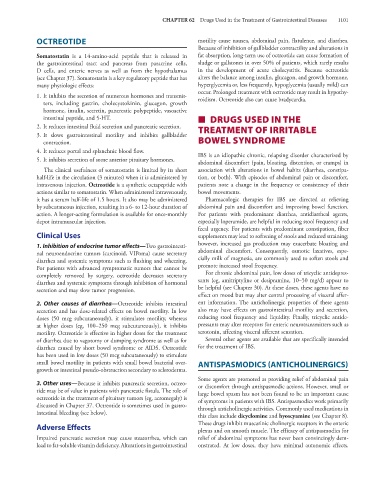Page 1115 - Basic _ Clinical Pharmacology ( PDFDrive )
P. 1115
CHAPTER 62 Drugs Used in the Treatment of Gastrointestinal Diseases 1101
OCTREOTIDE motility cause nausea, abdominal pain, flatulence, and diarrhea.
Because of inhibition of gallbladder contractility and alterations in
Somatostatin is a 14-amino-acid peptide that is released in fat absorption, long-term use of octreotide can cause formation of
the gastrointestinal tract and pancreas from paracrine cells, sludge or gallstones in over 50% of patients, which rarely results
D cells, and enteric nerves as well as from the hypothalamus in the development of acute cholecystitis. Because octreotide
(see Chapter 37). Somatostatin is a key regulatory peptide that has alters the balance among insulin, glucagon, and growth hormone,
many physiologic effects: hyperglycemia or, less frequently, hypoglycemia (usually mild) can
occur. Prolonged treatment with octreotide may result in hypothy-
1. It inhibits the secretion of numerous hormones and transmit- roidism. Octreotide also can cause bradycardia.
ters, including gastrin, cholecystokinin, glucagon, growth
hormone, insulin, secretin, pancreatic polypeptide, vasoactive
intestinal peptide, and 5-HT. ■ DRUGS USED IN THE
2. It reduces intestinal fluid secretion and pancreatic secretion. TREATMENT OF IRRITABLE
3. It slows gastrointestinal motility and inhibits gallbladder
contraction. BOWEL SYNDROME
4. It reduces portal and splanchnic blood flow. IBS is an idiopathic chronic, relapsing disorder characterized by
5. It inhibits secretion of some anterior pituitary hormones.
abdominal discomfort (pain, bloating, distention, or cramps) in
The clinical usefulness of somatostatin is limited by its short association with alterations in bowel habits (diarrhea, constipa-
half-life in the circulation (3 minutes) when it is administered by tion, or both). With episodes of abdominal pain or discomfort,
intravenous injection. Octreotide is a synthetic octapeptide with patients note a change in the frequency or consistency of their
actions similar to somatostatin. When administered intravenously, bowel movements.
it has a serum half-life of 1.5 hours. It also may be administered Pharmacologic therapies for IBS are directed at relieving
by subcutaneous injection, resulting in a 6- to 12-hour duration of abdominal pain and discomfort and improving bowel function.
action. A longer-acting formulation is available for once-monthly For patients with predominant diarrhea, antidiarrheal agents,
depot intramuscular injection. especially loperamide, are helpful in reducing stool frequency and
fecal urgency. For patients with predominant constipation, fiber
Clinical Uses supplements may lead to softening of stools and reduced straining;
1. Inhibition of endocrine tumor effects—Two gastrointesti- however, increased gas production may exacerbate bloating and
nal neuroendocrine tumors (carcinoid, VIPoma) cause secretory abdominal discomfort. Consequently, osmotic laxatives, espe-
diarrhea and systemic symptoms such as flushing and wheezing. cially milk of magnesia, are commonly used to soften stools and
For patients with advanced symptomatic tumors that cannot be promote increased stool frequency.
completely removed by surgery, octreotide decreases secretory For chronic abdominal pain, low doses of tricyclic antidepres-
diarrhea and systemic symptoms through inhibition of hormonal sants (eg, amitriptyline or desipramine, 10–50 mg/d) appear to
secretion and may slow tumor progression. be helpful (see Chapter 30). At these doses, these agents have no
effect on mood but may alter central processing of visceral affer-
2. Other causes of diarrhea—Octreotide inhibits intestinal ent information. The anticholinergic properties of these agents
secretion and has dose-related effects on bowel motility. In low also may have effects on gastrointestinal motility and secretion,
doses (50 mcg subcutaneously), it stimulates motility, whereas reducing stool frequency and liquidity. Finally, tricyclic antide-
at higher doses (eg, 100–250 mcg subcutaneously), it inhibits pressants may alter receptors for enteric neurotransmitters such as
motility. Octreotide is effective in higher doses for the treatment serotonin, affecting visceral afferent sensation.
of diarrhea due to vagotomy or dumping syndrome as well as for Several other agents are available that are specifically intended
diarrhea caused by short bowel syndrome or AIDS. Octreotide for the treatment of IBS.
has been used in low doses (50 mcg subcutaneously) to stimulate
small bowel motility in patients with small bowel bacterial over- ANTISPASMODICS (ANTICHOLINERGICS)
growth or intestinal pseudo-obstruction secondary to scleroderma.
Some agents are promoted as providing relief of abdominal pain
3. Other uses—Because it inhibits pancreatic secretion, octreo- or discomfort through antispasmodic actions. However, small or
tide may be of value in patients with pancreatic fistula. The role of large bowel spasm has not been found to be an important cause
octreotide in the treatment of pituitary tumors (eg, acromegaly) is of symptoms in patients with IBS. Antispasmodics work primarily
discussed in Chapter 37. Octreotide is sometimes used in gastro- through anticholinergic activities. Commonly used medications in
intestinal bleeding (see below).
this class include dicyclomine and hyoscyamine (see Chapter 8).
These drugs inhibit muscarinic cholinergic receptors in the enteric
Adverse Effects plexus and on smooth muscle. The efficacy of antispasmodics for
Impaired pancreatic secretion may cause steatorrhea, which can relief of abdominal symptoms has never been convincingly dem-
lead to fat-soluble vitamin deficiency. Alterations in gastrointestinal onstrated. At low doses, they have minimal autonomic effects.

